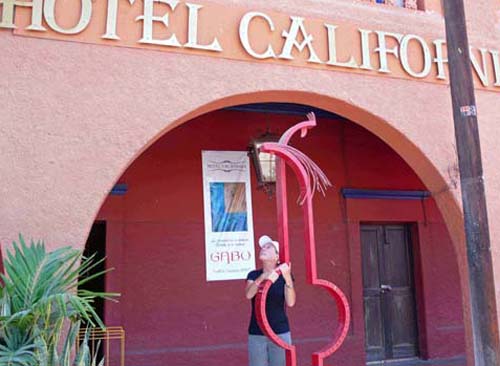The early 1700s were busy times for the Jesuit missionaries bringing Christianity to western Mexico's Baja Peninsula (whether the natives wanted it or not). By 1721, the padres were saving souls at a dozen missions on the lower Baja including a big one at La Paz on the Sea of Cortes.
They built the next one three years later at a sort of mini-Eden called Todos Santos (All Saints) on the Pacific side of the peninsula. The mission of the new mission -- the Jesuits named it Santa Rosa de las Palmas -- was to supply the one at La Paz.

What the larger mission mainly needed was fresh water. And Todos Santos had plenty of it, having been blessed with two natural springs gushing crystal-clear water from the nearby mountains. La Paz was also short on things to eat, like fruits and vegetables, and on treats such as wine and sugar. Thanks to the two springs, Todos Santos had irrigated farms that could supply all that, too.
Other foreigners soon took notice of the oasis at Todos Santos. For instance, sugar merchants became familiar figures at the mission. Business was booming.
But things weren't going so well at some of the other missions. For instance, after centuries of worshiping lots of gods, not all of the natives were eagerly latching on to the concept of a single deity. So the padres metered out punishment to help them see the light, which in turn prompted rebellions, mission burnings and even disappearing padres.
Todos Santos lost one of its best customers when -- sparked in part by a Jesuit edict banning the local Indians' traditional practice of polygamy -- the natives booted out the bringers of Christianity to La Paz.
Still, the springs of Todos Santos kept gushing, and its farms kept producing. Especially sugar cane. Even when more rebellions drove the padres to shift their soul-saving to the northern part of the Baja, the demand for Todos Santos' sugar grew and grew.
Fast forward to the end of the 19th century, and Todos Santos is the sugar cane capital of the entire Baja with no less than eight mills cranking out the sweet stuff.
The good old days lasted until 1950, when -- in the midst of dropping prices for sugar after World War II -- the largest of the two springs dried up. The mills began closing, and by 1955 the city was out of the sugar business.
A few decades later, when big resorts started popping up around Mexico, including one at Cabo San Lucas at the tip of the Baja 50 miles south, the unspoiled charm of Todos Santos began luring the likes of artists, sculptors, painters and poets there.
As if to welcome the newcomers, the large freshwater spring came back to life in 1981.
What's the town like today? Think of a sleepy Mexican farming and fishing village with perhaps 5,000 local folks. But look closer, and you'll spot a number of things that tell you this is no ordinary village. First, rubbing elbows with the locals are 1,000 American and Canadian expats, many of whom can be seen painting, weaving, making jewelry, spinning pottery wheels and otherwise creating gorgeous objects d'art. Second, the town's cobbled lanes are dotted with modest (but not inexpensive) galleries selling all this.
And who's buying those treasures? Tourists, mostly hopping off dozens of tour buses from what's now a mega-resort at Cabo San Lucas. Others drive to Todos Santos in rental cars from the resort or all the way from La Paz.
Look even closer, and you'll notice several very un-little-village-like gourmet restaurants around town. One is the famous Cafe Santa Fe, written up in dozens of magazines for its superb Italian dishes. Another is known for its Asian fusion menu.
Also unlike most run-of-the-mill villages, Todos Santos has about a dozen boutique inns and hotels, all told with around 250 rooms. One, the Hotel California, bills its accommodations as "11 sumptuously appointed, wildly imaginable rooms and suites." Once locally promoted as the hotel in the Eagles' 1976 hit song, "Hotel California" (lead singer Don Henley reportedly denied it), the property is close to the town's main shopping area and to what passes for the city's nightlife.
All in all, most people who get a chance to sample Todos Santos' old-world charm and its new-world paintings and carvings agree, it's still a sweet little town.
More info: Visit www.todossantos.cc and www.hotelcaliforniabaja.com.
Photo by Bob Schulman